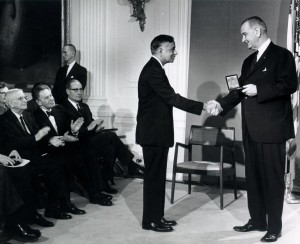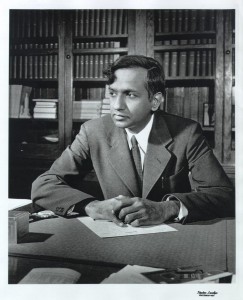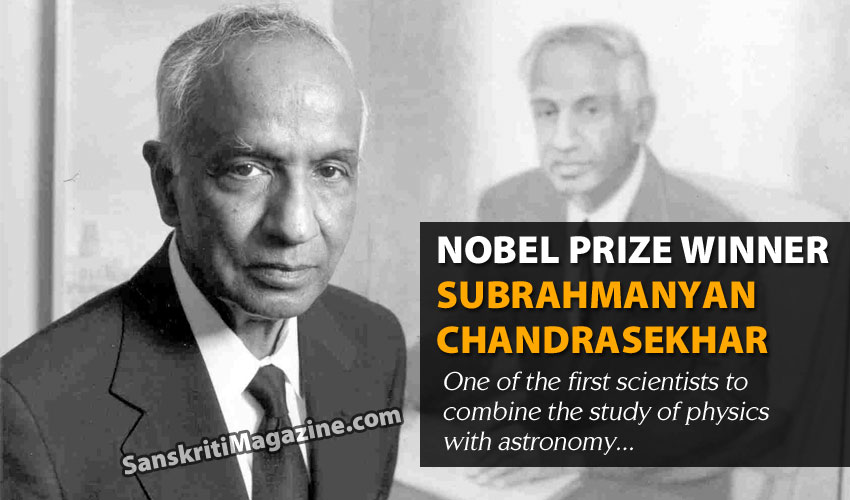Subrahmanyan Chandrasekhar was known to the world as Chandra. The word chandra means “moon” or “luminous” in Sanskrit.
Subrahmanyan Chandrasekhar was known throughout his life as Chandra. His father was C Subrahmanyan Ayyar and his mother was Sitalaksmi Aiyar. His father, an Indian government auditor whose job was to audit the Northwest Railways, came from a Brahman family which owned some land near Madras, India. Chandra came from a large family, having two older sisters, three younger brothers and four younger sisters. When Chandra was still young his parents moved to Madras and, as he grew up, he was encouraged to seek an education which would see him following his father into government service. However Chandra wanted to be a scientist and his mother encouraged him to follow this route. He had a role model in his paternal uncle Sir Chandrasekhara Venkata Raman who went on to win the Nobel prize in 1930 for his 1928 discovery of Raman scattering and the Raman effect, which is a change in the wavelength of light occurring when a beam of light is deflected by molecules.
 Chandra studied at Presidency College, University of Madras, and he wrote his first research paper while still an undergraduate there. The paper was published in the Proceeding of the Royal Society where it had been submitted by Ralph Fowler. Also at Presidency College with Chandra was Lalitha Doraiswamy, who was the daughter of a family living close to where Chandra’s family lived in Madras. They became engaged to marry at this time. Chandra obtained a scholarship from the Indian government to finance his studies in England, and in 1930 he left India to study at Trinity College, Cambridge, England. From 1933 to 1937 he undertook research at Cambridge, but he returned to India in 1936 to marry Lalitha on 11 September. Mestel writes :-
Chandra studied at Presidency College, University of Madras, and he wrote his first research paper while still an undergraduate there. The paper was published in the Proceeding of the Royal Society where it had been submitted by Ralph Fowler. Also at Presidency College with Chandra was Lalitha Doraiswamy, who was the daughter of a family living close to where Chandra’s family lived in Madras. They became engaged to marry at this time. Chandra obtained a scholarship from the Indian government to finance his studies in England, and in 1930 he left India to study at Trinity College, Cambridge, England. From 1933 to 1937 he undertook research at Cambridge, but he returned to India in 1936 to marry Lalitha on 11 September. Mestel writes :-
Their marriage, exceptionally, was by mutual choice rather than by arrangement. Lalitha’s family was also very interested in education, and before her marriage she worked as a school headmistress. She was an ever-present support for Chandrasekhar during their fifty-nine years together. There were no children of the marriage.
They returned to Cambridge in 1936 but in the following year Chandra joined the staff at the University of Chicago where he was to remain for the rest of his life. At first he worked in Yerkes Observatory, part of the University of Chicago in Wisconsin. Later he moved to work on the university campus in the city of Chicago. During World War II he worked in the Ballistic Research Laboratories at the Aberdeen Proving Ground in Maryland. Two reports, written in 1943, show the type of problems he was working on at this time: the first is On the decay of plane shock waves while the second is The normal reflection of a blast wave.
He was honoured with being appointed Morton D Hull distinguished service professor of the University of Chicago in 1952. Although by that time Chandra had been working in the United States for 15 years, neither he nor his wife had taken out citizenship earlier. However, both became American citizens in the following year and became very much integrated into the life of the country. When Chandra was offered a chair at Cambridge in 1964 he replied by return that he was not interested, so turning down a position which as a young man he would have found the most desirable.
Chandrasekhar published around 400 papers and many books. His research interests were exceptionally broad but we can divide them into topics and rough periods when he was concentrating on these particular topics. First he studied stellar structure, including the theory of white dwarfs, from 1929 to 1939, then stellar dynamics from 1939 to 1943. Next he looked at the theory of radiative transfer and the quantum theory of the negative ion of hydrogen from 1943 to 1950, followed by hydrodynamic and hydromagnetic stability from 1950 to 1961. During most of the 1960s he studied the equilibrium and the stability of ellipsoidal figures of equilibrium but during this period he also began work on topics from general relativity, the radiation reaction process, and the stability of relativistic stars. During the period from 1971 to 1983 he undertook research into the mathematical theory of black holes, then for the last period of his life he worked on the theory of colliding gravitational waves.
In 1930 Chandra showed that a star of a mass greater than 1.4 times that of the Sun (now known as the Chandrasekhar’s limit) had to end its life by collapsing into an object of enormous density unlike any object known at that time. He said:-
… one is left speculating on other possibilities …
namely objects such as black holes. However, this work led to a controversy between Chandra and Eddington who described Chandra’s work as:-
… almost a reductio ad absurdum of the relativistic degeneracy formula.
Eddington, who was a leading expert on relativity at this time, argued that:-
… there is no such thing as relativistic degeneracy!.
Chandra was very frustrated by the controversy with Eddington and to a certain extent it influenced the way that he worked through the rest of his life. Many years later Chandra was awarded the Nobel prize for Physics in 1983 –
… for his theoretical studies of the physical processes of importance to the structure and evolution of the stars.
He described this work in The Mathematical Theory of Black Holes (1983). He said that:-
… one of the ways in which one may explore the physical content of the general theory of relativity is to allow one’s sensibility to its aesthetic base guide in the formulation of problems with conviction in the harmonious coherence of its mathematical structure.
His other books include An Introduction to the Study of Stellar Structure (1939), Principles of Stellar Dynamics (1942), Radiative Transfer (1950), Plasma Physics (1960),Hydrodynamic and Hydromagnetic Stability (1961), Ellipsoidal Figures of Equilibrium (1969), Truth and Beauty: Aesthetics and Motivations in Science (1987), and Newton’s Principia for the Common Reader (1995). These texts have played a major role in mathematical astronomy. For example a reviewer wrote of Hydrodynamic and Hydromagnetic Stability:-
… the author has no peer in the treatment of his main topics of thermal and rotational instability.
Also the review of Principles of Stellar Dynamics rightly asserts:-
The book is written with exceptional clarity … [It] should prove stimulating to astronomer, mathematician and physicist.
Chandrasekhar was awarded the Royal Medal of the Royal Society of London in 1962:-
… in recognition of his distinguished researches in mathematical physics, particularly those related to the stability of convective motions in fluids with and without magnetic fields.
The Royal Society also awarded him their Copley Medal in 1984:-
… in recognition of his distinguished work on theoretical physics, including stellar structure, theory of radiation, hydrodynamic stability and relativity.
 From 1952 until 1971 Chandrasekhar was editor of the Astrophysical Journal . This journal was originally a local University of Chicago publication, but it grew in stature to become national publication of the American Astronomical Society, then a leading international journal.
From 1952 until 1971 Chandrasekhar was editor of the Astrophysical Journal . This journal was originally a local University of Chicago publication, but it grew in stature to become national publication of the American Astronomical Society, then a leading international journal.
Chandrasekhar received many honours for his outstanding contributions some of which, such as the Nobel prize for Physics in 1983, the Royal Society‘s Royal Medal of 1962 and their Copley Medal of 1984, we have mentioned above. We should also mention, however, that he was honoured with the Bruce medal of the Astronomical Society of the Pacific, the Henry Draper medal of the National Academy of Sciences (United States), and the Gold Medal of the Royal Astronomical Society.
Chandra retired in 1980 but continued to live in Chicago where he was made professor emeritus in 1985. He continued to give thought-provoking lectures such as Newton and Michelangelo which he delivered at the 1994 Meeting of Nobel Laureates held in Lindau. He compared Michelangelo’s frescoes in the Sistine Chapel and Newton’s Principia :-
… in the larger context of whether there is any similarity in the motivations of scientists and artists in their respective creative quests.
Other lectures in a similar vein include Shakespeare, Newton and Beethoven or patterns of creativity and The perception of beauty and the pursuit of science.
Chandrasekhar remained active and published in final major book Newton’s Principia for the Common Reader at 85 years of age in the final months of his life. Shortly after publication of this work he died from heart failure and was buried in Chicago. He was survived by his wife Lalitha. Let us end this biography by quoting the words of Tayler from :-
[Chandrasekhar] was a classical applied mathematician whose research was primarily applied in astronomy and whose like will probably never be seen again.
~ J.J. O’Connor and E F Robertson











